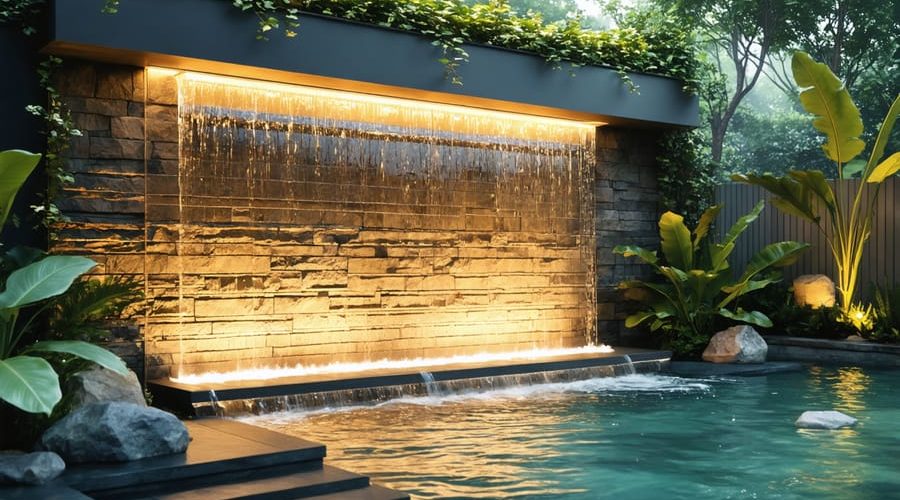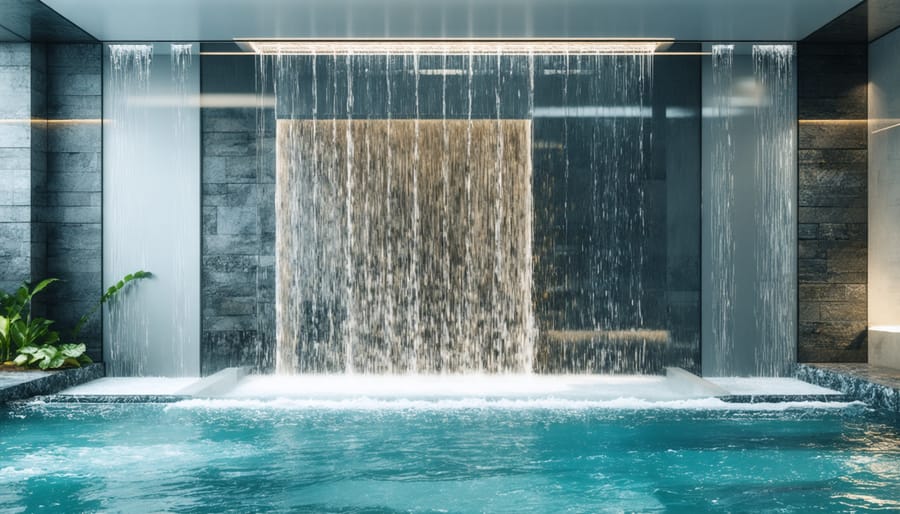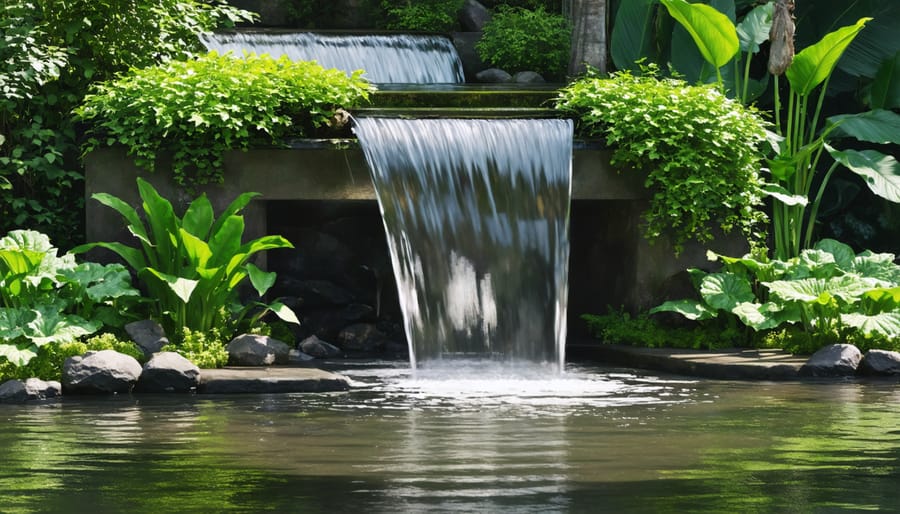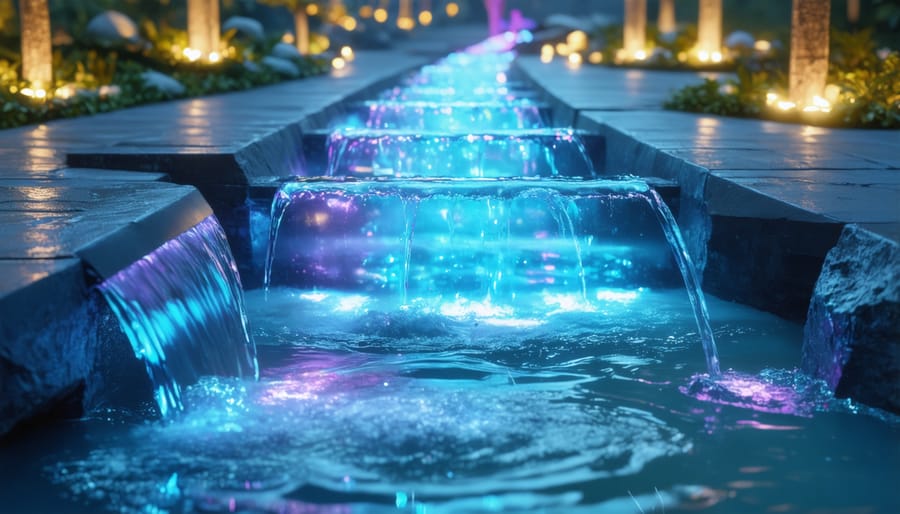
Transform Your Backyard with These Show-Stopping Water Features
Transform your outdoor space into a mesmerizing oasis with a water feature that defies convention and captivates the senses. Beyond traditional fountains and garden ponds lies a world of innovative water designs that blend artistry with nature’s most essential element. From cascading water walls that double as living artwork to musical water sculptures that dance with light and sound, today’s unique water features serve as stunning focal points while creating a sense of tranquility and wonder.
Modern designers are reimagining the possibilities of water in landscape architecture, incorporating sustainable technologies and unexpected materials to craft installations that feel both timeless and contemporary. Whether it’s a floating sphere fountain that appears to defy gravity, a rainfall curtain that creates a transparent room division, or a bio-filtered natural swimming pond that harmonizes with its surroundings, these distinctive water features do more than simply add visual interest – they transform spaces into immersive experiences.
As homeowners increasingly seek to create outdoor sanctuaries that reflect their personal style, the demand for extraordinary water features continues to grow. This guide explores cutting-edge designs, innovative materials, and expert installation techniques that will help you create a truly unique water feature that sets your landscape apart while maintaining perfect harmony with its environment.

Vertical Water Walls: Modern Elegance Meets Nature
Design Options and Materials
When it comes to vertical water walls, the possibilities are endless. Natural stone options like slate, granite, and quartzite create a rustic, organic feel while offering durability and unique texture patterns. For a modern aesthetic, consider stainless steel or copper panels, which develop a beautiful patina over time. Glass panels offer a contemporary look and can be customized with etched designs or colored lighting effects.
The frame structure can be constructed from weather-resistant materials like aluminum or treated wood, depending on your design preferences. Many DIY enthusiasts opt for pre-made water wall kits that include essential components like pumps and reservoirs, making installation more straightforward.
Surface treatments also play a crucial role in the overall effect. Textured surfaces create more dramatic water patterns, while smooth surfaces produce sheet-like water flow. Consider incorporating LED lighting strips to illuminate the water, creating stunning evening displays. You can also add decorative elements like river rocks or preserved moss around the base to enhance the natural appearance.
For eco-conscious homeowners, recycled materials like repurposed window panes or salvaged metal sheets can create unique, sustainable designs while adding character to your outdoor space.
Installation Considerations
Before installing a vertical water wall, carefully assess your wall’s structural integrity to ensure it can support the weight and water pressure. The wall should be completely waterproof and properly sealed to prevent moisture damage. Understanding basic water feature mechanics is essential for proper installation.
Consider the power source location and ensure easy access to electricity and water supply lines. You’ll need a dedicated circuit for the pump and lighting systems. The drainage system is crucial – install a catch basin at the bottom to collect and recirculate water effectively.
Proper lighting placement enhances the feature’s visual impact after dark. Position lights to create subtle shadows and highlight water movement. Think about viewing angles and ensure the feature is visible from your preferred spots, whether it’s your patio or through windows.
Climate considerations are vital too. In freezing climates, install a system that can be easily drained for winter, and choose materials that withstand temperature fluctuations. Finally, plan for regular maintenance access to clean filters and adjust water flow as needed.
Living Water Features: Blending Flora and Flow
Plant Selection for Water Features
Choosing the right plants can transform your water feature into a vibrant, living ecosystem. Integrating aquatic plants not only adds visual interest but also helps maintain water quality naturally.
For deep water zones, consider classic water lilies in various colors – they’re perfect for adding floating blooms and shade. Hardy varieties like Nymphaea ‘Colorado’ or ‘Attraction’ are excellent choices for beginners. Along the margins, try iris pseudacorus (yellow flag iris) or pickerelweed for vertical interest and gorgeous flowers.
Shallow areas benefit from marsh marigolds and water forget-me-nots, which create a lovely transition between water and land. For oxygenating purposes, include submerged plants like hornwort or anacharis – they’re workhorses that keep water clear and healthy.
Most aquatic plants are low-maintenance, needing only occasional trimming and basic fertilization. Plant them in aquatic baskets using special pond soil, and position according to their depth requirements. Remember to remove dead foliage regularly and divide overgrown plants every few years to keep your water feature looking its best and functioning properly.

Maintaining Balance
Maintaining a healthy balance in your water feature requires regular attention, especially when incorporating living elements like plants and fish. Start by testing your water quality weekly using simple test strips to monitor pH levels, which should typically stay between 6.8 and 7.2. Add beneficial bacteria monthly to help break down organic matter and maintain crystal-clear water.
For features with aquatic plants, trim dead leaves and flowers promptly to prevent decay. Consider adding floating plants like water lilies or lotus, which naturally filter water and provide shade for fish. When keeping fish, avoid overstocking – a good rule of thumb is one inch of fish per square foot of surface area.
Install a reliable filtration system sized appropriately for your water volume, and clean it according to the manufacturer’s guidelines. During hot months, top up water levels regularly to compensate for evaporation, using dechlorinated water to protect aquatic life.
In autumn, use pond netting to catch falling leaves before they sink and decompose. For winter preparation, remove tender plants, reduce feeding, and consider adding a pond heater in colder climates to maintain a small opening in the ice for gas exchange.
Interactive Water Features
Musical Water Features
Transform your outdoor space into an enchanting musical experience with features that combine the soothing elements of water with delightful sounds. Musical water features can range from simple chime fountains to sophisticated installations that respond to movement and create harmonious melodies.
One popular option is the water bell fountain, where water flows over metal bells of varying sizes, creating gentle, resonant tones as the water drops strike them. For a more interactive experience, consider motion-sensitive water jets that dance and play different musical notes when someone walks nearby.
Bamboo water features offer a natural musical element, with water trickling through hollow bamboo pipes to create soft, peaceful sounds reminiscent of traditional Asian gardens. You can customize the pitch by adjusting the length and diameter of the bamboo pieces.
For a modern twist, some homeowners are installing programmable water features that synchronize water movement with music, creating spectacular water shows right in their backyard. These systems can be controlled via smartphone apps, allowing you to change the music and water patterns to suit different occasions.
Even simple additions like carefully placed rocks can create musical effects as water flows over them, producing different tones based on the rock’s shape and size.
LED and Light Integration
Transform your water feature into a mesmerizing nighttime display with strategic lighting integration. LED lights are perfect for creating stunning effects, offering energy efficiency and long-lasting illumination. Consider installing color-changing LEDs to set different moods throughout the evening or match your outdoor décor for special occasions.
When planning your outdoor lighting options, focus on highlighting key areas like water streams, cascades, or specific architectural elements. Submersible lights work wonderfully beneath the water’s surface, creating mysterious depth and bringing life to your feature after dark. Install spotlights around the perimeter to emphasize vertical elements or place strip lighting along edges for a contemporary feel.
For added drama, try positioning lights behind falling water to create a shimmering curtain effect. Motion-activated lights can add an element of surprise, while smart LED systems allow you to control brightness and colors from your phone. Remember to use waterproof fixtures rated for outdoor use, and consider installing a timer to automate your lighting schedule, saving energy while ensuring your water feature remains a focal point throughout the evening.

Sustainable Water Feature Innovations
Water Conservation Techniques
Creating an eco-friendly water feature doesn’t mean compromising on beauty. Start by installing a recirculating pump system, which reuses water instead of continuously drawing from a fresh source. Consider adding a rain harvesting system to collect natural precipitation for your feature – it’s both sustainable and cost-effective.
Smart timer controls can significantly reduce water waste by operating your feature only during peak viewing hours. Adding an auto-fill valve helps maintain optimal water levels without overflowing. For splash reduction, incorporate river rocks or decorative barriers around the edges of your water feature.
Choose drought-resistant aquatic plants that require minimal water to thrive. Installing a water filter system helps keep the water clean longer, reducing the frequency of refills. Following proper maintenance guidelines will prevent leaks and ensure efficient water use. Consider using a solar cover when the feature isn’t in use to minimize evaporation, especially during hot summer months.
Solar-Powered Solutions
Harness the power of the sun to create an eco-friendly and cost-effective water feature that runs all day long. Solar-powered pumps and features have come a long way, offering reliable performance even on cloudy days. The key is selecting the right solar panel size for your feature – a general rule is to choose a panel that delivers 20% more power than your pump requires.
For maximum efficiency, position your solar panels where they’ll receive direct sunlight for most of the day. Consider using a battery backup system, which stores excess energy during sunny hours to keep your feature running during overcast periods or after sunset. Modern solar controllers even allow you to adjust flow rates and create different water patterns throughout the day.
Small solar-powered features can be as simple as floating fountains, while larger installations might incorporate multiple panels to power cascading waterfalls or elaborate pond systems. The initial investment in solar equipment typically pays for itself within two years through energy savings.
Creating a unique water feature is more than just adding beauty to your outdoor space – it’s about crafting a personal oasis that reflects your style and enhances your daily life. Throughout this guide, we’ve explored various innovative designs, from mesmerizing floating spheres to captivating wall cascades, each offering its own distinct charm and character.
Remember that the perfect water feature combines aesthetic appeal with practical functionality. Whether you choose a contemporary LED-lit design or a naturalistic stream, your creation will provide a focal point that engages multiple senses and creates a tranquil atmosphere in your outdoor space.
The benefits of installing a unique water feature extend far beyond visual appeal. The soothing sounds of flowing water can mask unwanted noise, while the feature itself attracts wildlife and creates a cooler microclimate in your garden. Plus, the satisfaction of designing and building your own water feature adds an extra layer of personal connection to your outdoor sanctuary.
Don’t be afraid to start small and expand your vision over time. Begin with a simple design that speaks to you, and as your confidence grows, you can add more elements or create additional features. The most important thing is to take that first step toward transforming your outdoor space into something extraordinary.
Ready to begin your water feature journey? With proper planning, the right materials, and a dash of creativity, you’re well-equipped to create a stunning focal point that will bring joy for years to come.
